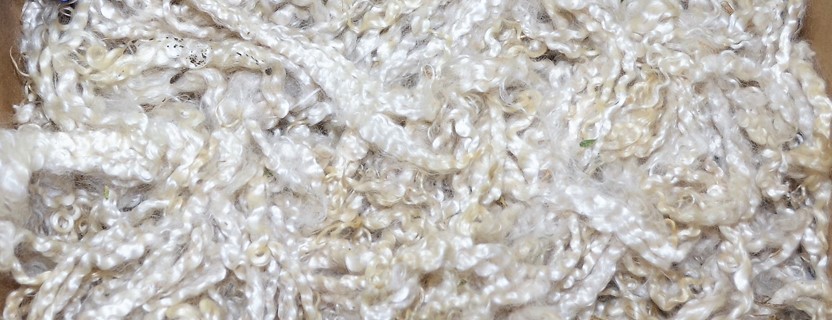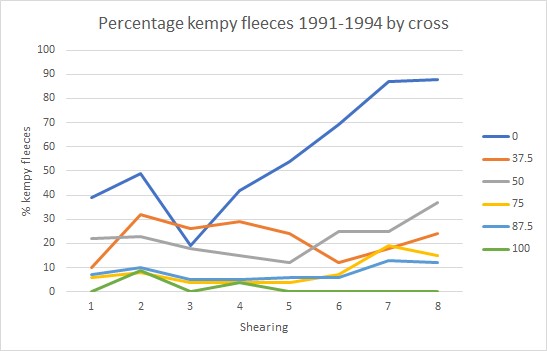
This page contains comments and information about mohair and mohair biology. Updates will be added as questions are raised requiring clarification.
Kemp is the name for short, coarse fibres in the fleece of sheep and Angora goats. Kemp is seen as a fault in apparel fleece since it imparts a prickle and fails to dye properly. As such it stands out as a fleck in woven fabrics. Fortunately, being relatively short kemp fibres are largely lost during combing however, the greater the amount of kemp in the raw fleece, the greater the residual amount left in the top and then in the yarn spun from it.
In mohair, kemp is seen as an impurity being the result of cross breeding to milk or non-fleece bearing breeds. Crossbreeding typically occurs when mohair prices are high and pure Angoras are in short supply. Kemp then is in effect, the residual coat of short haired animals.
To varying degrees kemp is visible in the mohair fleece. Over time breeders have selected against visible kemp resulting in a reduction of the number of these fibres and the length. Both the proportion and the length determine the degree of “kempiness” and so the classification of fleeces as “kempy”. Unfortunately, measurement of the proportion of kemp fibres in the fleece is both tedious and inaccurate with repeated counts under the microscope having a low correlation (repeatability) with the variation in percentage being as high as the total variation between animals.
Modern Angora goats have very little kemp in their fleece, but it can still be seen on the backline of many animals. There is a tendency for kemp to increase with age and aged animals produce a light fleece with noticeable kempiness. Such fleeces are classed as FHK or FHX.
Prior to the release of imported Angoras from Texas and South Africa in 1992, Australian Angora goats demonstrated high levels of kemp. Almost all adult mohair was classed as “kempy”. Whether this was the result of lack of selection or from the high level of crossbreeding is difficult to say. Certainly, observations of successive crosses to Angora bucks demonstrated a reduction but still, the “purebred” Angoras were often kempy. Successive crosses to imported lines demonstrated a further progression to almost kemp free animals. However, progress was slow so kemp must be viewed as potentially a long-term problem. It would be a mistake to see back-crossing as an effective way of rapid increase in mohair production.

Here is a plot of the percentage of kempy fleeces observed in various crosses to Texan sires.
Following the release of the Texan imports in 1992 the author’s Cudal Mohair stud began a back crossing exercise with over 1100 animals. Over 2 years doe kids of various crosses were produced and tracked for 8 shearings. From the graph it can be seen that the original Australian doe kids were often quite kempy and by the 8th shearing were mostly classed as kempy at shearing.
Some 75% Texan sires were used resulting in some 37.5% kids. Most of the kids born were 50% but a small number of second and third cross kids were also born. As with all observational data there is some degree of random variation but the trends are clear. While the % of kempy fleeces dropped quickly with back crossing, the character was not quickly eliminated.
Why shearing between October and December is not a good idea.
Like most animals, goats tend to shed their coat in Spring. Merino sheep and Angora goats have been bred to hold onto their fleece and keep growing the fibre. But there is a residual, innate shedding cycle with hair follicles slowing in their activity in winter. This is followed by a low percentage (5 to 20%) of follicles ceasing production (resulting in the fibre shedding) and then beginning again to grow a new fibre. The shed fibres tend to weave their way through the fleece causing anything from a mild cross fibredness to a full Cot or mat.
The advice is to shear before this situation creates a problem. The longer you wait (for a shearer or for a longer fleece) the worse things get.
Early in the last century the Texans believed that it was the green grass in spring that caused the shedding. Not so. Studies on housed goats given a constant ration still shed and experiments with reversed day length produced a shedding after the artificial “shortest day”. While there are differences in flocks the solution to the problem is shearing time rather than selection against the problem.
So don’t wait. Try to get the shearing done in August or September (and then February or March).
DS

Here are 7 staples of dyed mohair. The scouring and boiling in dyestuff has tightened the staples. The staples come from the one fleece and demonstrate the characteristic crimp and twist of good mohair. However, the two staples on the right show excessive twist in the same direction. These staples will tighten on the carding material and will be difficult to break up into workable mohair fibre.


Photomicrograph of mohair fibres; note smooth cuticular scales and straight fibre snippets.
Mohair is a wool-like textile fibre produced as a “simple” fleece on Angora Goats. The Angora breed originated in what is now Turkey. It was exported (with some difficulty) to many countries from the 1840’s and this resulted in substantial mohair producing industries developing in South Africa and Texas (USA). Australia and Argentina also established industries but they failed to prosper in those times. Mohair is a protein fibre like wool. It has a smooth cuticular scale pattern on the surface (see photomicrograph left) imparting lustre and low felting capacity. It grows rapidly at about 2cm per month and is shorn every six months. The fibre ranges from about 23 microns in mean diameter at the first shearing, to as much as 38 microns in older animals. This large increase in fibre diameter as the animals age results in a large range of uses for the fibre. “Kid” mohair is used in knitwear, intermediate diameter mohair (often referred to as “Young Goat”) is used in suiting materials while the stronger “Adult” or “Fine Hair” types are used in coating and rug manufacture. Mohair has a distinctive lock structure with a twist and a wave (called style and character) and pointed tip resulting from fibres of different length within the staple (see photo right and below).

Mohair exemplifies the everlasting appeal of beauty and quality. It is a long, lustrous and strong fibre. The distinctive properties of mohair have made it a highly desirable for both clothing and furnishings. Its soft, luxurious handle and rich lustre combine with great durability for a long lasting product. With its high affinity for dyes, mohair produces colours that have an unmatched clarity and halo-like glow.
Fabrics containing lively, smooth mohair are not easily crushed or felted. Mohair is an all-season fashion fibre, in wonderful warm knits and woven for cool weather, and in airy, lightweight structures that breath with the body on warm days. Used alone or in blends, mohair imparts a unique signature to the infinite variety of fabric textures, from lofty fleeces, rich tweeds and frothy knits, to crisp men’s suiting cloths.
As a decorating fabric, mohair is valued for its flame resistance and high sound absorbency. It is ideal for public places such as symphony halls, theaters, hotel lobbies, offices as well as for homes. In addition mohair drapes are effective insulators, keeping heat in during cold weather and serving as a barrier against outside heat in summer. As traditional velours, mohair upholstery is an absolute necessity as a covering for chairs and lounges in the traditional style.
Mohair can be used in many items; accessories for hats, scarves, lounging boots and slippers; throws and blankets; carpeting and rugs; wigs; paint rollers and ink transfer pads; and childrens’ toys.

Mohair falls in long ringlets though there are differences in staple structure. Some animals produce flat locks while others produce spiral or curled locks. Both these types are considered less desirable (photo above illustrates well balanced structure and excessively styled or twisted locks). When examining mohair fleeces on an animal use two hands to separate and list the fibre to examine the natural structure. While neck mohair may be stronger and can sometimes have excessive style overall uniformity is considered a measure of high quality.

The yellow circles in the photo above are mohair fibres in cross section. Each is surrounded by the follicle itself. At the top are Primary or kemp producing follicles. The medulla or loose-packed core of these fibres is stained red. This structure is similar to that in the skin of sheep and Alpacas. In Merino sheep the primary follicles are the same size as the “secondary” wool producing follicles and the fibre produced is either identical to wool or is “vestigial”. A Concept of Quality – Here is a detailed discussion on aspects of mohair and Angora quality published from MOHAIR : Farming the Diamond Fibre. D L Stapleton 2017 Click for Concepts of Quality A Click for Concepts of Quality B